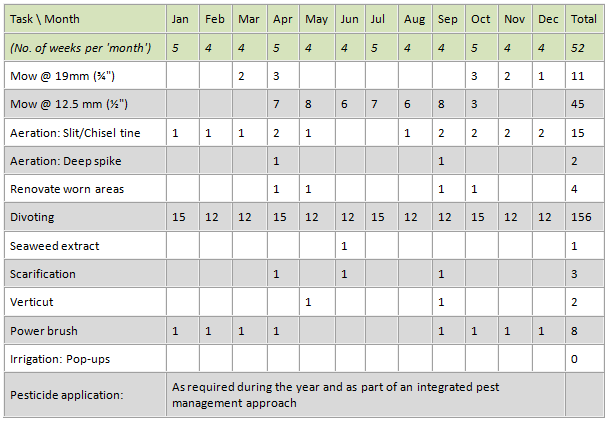The estimated number of occasions for which each task is planned to be carried out can be presented in the form of a maintenance calendar.
The total number of actual operations will vary according to the prevailing weather conditions, as well as the geographic location of the golf course; each factor can influence the length of the growing season and grass vigour.
Maintenance calendars can provide a very useful means for forward planning and the information can be converted into a staff profile, indicating workload levels, material requirements or budget flow.
The 'Months' in the Table are given as 4 or 5 week periods for convenience; this still adds up to 13 weeks per quarter. There is no reason why, for example, the January month is given as 5 weeks, so long as each quarterly block is made up of one 5 week period and the other two are 4 week periods, thus giving 13 weeks for each quarter.
It is useful to have April as a 5 week period as it gives some more leeway in planning, although this is probably arbitrary.
Each month could also be the exact number of days in a calendar month. Whichever system works for the user, then this is the one which should be adopted.
Example of a maintenance calendar

Download a word version so you can edit it to suit your own requirements
Note 1: Due to possible time limitations, an estimated 50% (8 ha) is vertidrained in spring and 50% in autumn.
Note 2: April/May and September/October will be the main periods when fairway renovation work will take place.
Note 3: Divoting is planned to be carried out on 3 fairways per week, on a continuous rotation basis. It therefore takes 6 weeks to complete all the fairways.
Note 4: Any irrigation that takes place would be negligible in this example.
Pesticide application would be targeted to specific fairways, or parts of, with it being unlikely (hopefully!) that the total extent of the fairway grass is to be sprayed.
With records kept of past activities (and a diary of work carried out is obviously kept!) the turf manager will be able to have a reasonable idea of the likely maintenance requirements.
More specialist operations, such as aeration using compressed air, power drills or water injected, may also be listed if used. Leaf removal, attention to mole hills and rabbit scrapes may also be included if desired, as could sanding of muddy traffic areas and the fencing off of worn areas using pig irons and tape.
Care with all operations will obviously have to be taken, particularly on recently divoted areas.
